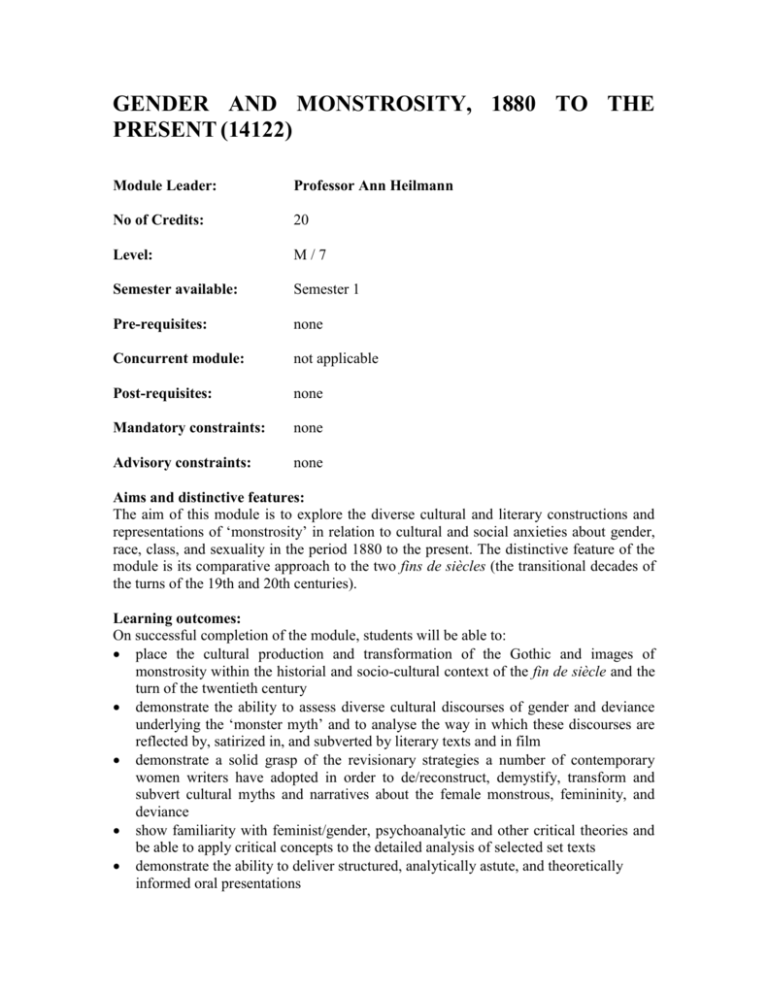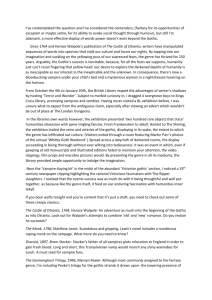Module Leader: Professor Ann Heilmann
advertisement

GENDER AND MONSTROSITY, 1880 TO THE PRESENT (14122) Module Leader: Professor Ann Heilmann No of Credits: 20 Level: M/7 Semester available: Semester 1 Pre-requisites: none Concurrent module: not applicable Post-requisites: none Mandatory constraints: none Advisory constraints: none Aims and distinctive features: The aim of this module is to explore the diverse cultural and literary constructions and representations of ‘monstrosity’ in relation to cultural and social anxieties about gender, race, class, and sexuality in the period 1880 to the present. The distinctive feature of the module is its comparative approach to the two fins de siècles (the transitional decades of the turns of the 19th and 20th centuries). Learning outcomes: On successful completion of the module, students will be able to: place the cultural production and transformation of the Gothic and images of monstrosity within the historial and socio-cultural context of the fin de siècle and the turn of the twentieth century demonstrate the ability to assess diverse cultural discourses of gender and deviance underlying the ‘monster myth’ and to analyse the way in which these discourses are reflected by, satirized in, and subverted by literary texts and in film demonstrate a solid grasp of the revisionary strategies a number of contemporary women writers have adopted in order to de/reconstruct, demystify, transform and subvert cultural myths and narratives about the female monstrous, femininity, and deviance show familiarity with feminist/gender, psychoanalytic and other critical theories and be able to apply critical concepts to the detailed analysis of selected set texts demonstrate the ability to deliver structured, analytically astute, and theoretically informed oral presentations show detailed understanding of critical methodologies in the field, and be able to apply these in oral and written work Learning and teaching strategy: The module will be taught by means of ten two-hour seminars, and will in the main be led by student presentations. Three film viewings will be compulsory; further film and documentary viewings will be optional. Students will be required to read and prepare critical theory extracts throughout. Arrangements for revision and private study: Students will be encouraged to consult the tutor on essay preparation during office hours. The Christmas vacation will provide a natural break for essay research and preparation. Assessment strategy: One presentation (with handout and bibliography), 30%; one extended analytical or creative 4,000 word essay, 70% (if creative, an analytical component is mandatory). Method of re-assessment: As above (presentation to be given to module convenor). Indicative content: The emergence of cultural fears of ‘monsters’ is particularly vibrant in the collective unconscious in times of political, social, and cultural upheavals, such as the turn of centuries, which spell beginnings and endings, the loss of old belief structures and the quest for new certainties, confusion and experimentation. What do the prevailing images of monstrosity of the 1880s to 1900s and 1980s to the present tell us about the fears and fantasies of the time, and how are these anxieties reflected and conceptualised in Gothic terms in literature and other forms of cultural production such as film? Drawing on feminist and psychoanalytic theory, we will discuss the cultural and psychological constructions of moral 'evil' and sexual danger attributed to the (gendered, raced, sexed, classed) Other at the two fins de siècle and explore the ways in which contemporary writers have adapted, modernised, politicized, and subverted Victorian forms of Gothic. The course will be accompanied by separate video sessions, three of which are compulsory. Introduction The monstrous female (Victorian): H. Rider Haggard, She The monstrous female (contemporary): Margaret Atwood, The Robber Bride Spirituality, monstrosity, and lesbian desire in neo-Victorian fiction: Sarah Waters, Affinity (extracts from: Henry Mayhew; Michel Foucault; Terry Castle) Critical theory session (Gothic, Uncanny, Fantasy, Abjection; extracts from: Fred Botting; Sigmund Freud; Tzvetan Todorov; Rosemary Jackson; Julia Kristeva) applied to: Meshes of the Afternoon (Maya Deren, 1943) The haunted mind: Henry James, ‘The Turn of the Screw’ and The Others (Alejandro Amenabar, 2001) [separate film viewing] (Extracts from: Sigmund Freud; Laura Mulvey; Julia Kristeva, ‘Stabat Mater’) The double brain, multiplex personality, and the unconscious: George Moore, ‘John Norton’ (extracts from: Frederick Myers; medical literature on the double brain; Max Nordau; Richard von Krafft-Ebing; Sigmund Freud; Elisabeth Bronfen) Versions of the female vampire: Sheridan Le Fanu, ‘Carmilla’ and Arabella Kenealy, ‘A Beautiful Vampire’; Jewelle Gomez, ‘Louisiana’ and Angela Carter, ‘Lady of the House of Love’ Fairytale and Little Red Riding Hood’s subversions: Historical versions (‘The Story of Grandmother’, Perrault, Brothers Grimm); Angela Carter, ‘The Werewolf’, ‘Wolf Alice’, and ‘The Company of Wolves’; The Company of Wolves (Neil Jordan, 1984, script jointly with Carter) [separate film viewing] (Extracts from: Maria Tatar; Jack Zipes) Uncanny bodies and the fantastic: Angela Carter, The Magic Toyshop Indicative bibliography: Atwood, Margaret (1994) The Robber Bride (London: Virago). Carter, Angela (1981) The Bloody Chamber and Other Stories (London: Penguin) [Set reading: ‘Lady of the House of Love’, ‘The Werewolf’, ‘The Company of Wolves’ and ‘Wolf Alice’] Carter, Angela (1982) The Magic Toyshop (London: Virago). James, Henry (1898) ‘The Turn of the Screw’. Any edition. Online edition: http://etext.virginia.edu/toc/modeng/public/JamTurn.html Kenealy, Arabella (1896) ‘A Beautiful Vampire’, The Ludgate, vol.3, pp. 35-46. Le Fanu, Sheridan (1871) ‘Carmilla’, in Pam Keesey, ed. (1997) Daughters of Darkness: Lesbian Vampire Stories. Pittsburgh: Cleis, pp.27-87. (Any edition) Online edition: http://www.gutenberg.org/etext/10007 Gomez, Jewelle (1991) ‘Louisiana: 1850’, in Pam Keesey, ed. (1993) Daughters of Darkness: Lesbian Vampire Stories (Pittsburgh: Cleis), pp. 97-135. [You may want to have a look at Gomez’ novel, from which this chapter is taken: The Gilda Stories, Firebrand Books] Moore, George (1895) ‘John Norton’, Celibates (London: Walter Scott), pp.315-454. Rider Haggard, H. (1887) She. (Oxford: Oxford University Press). Waters, Sarah (2000) Affinity (London: Virago). Set critical theory reading: Botting, Fred (1996) ‘Introduction: Gothic Excess and Transgression’, Gothic. London: Routledge, pp. 1-20. Kristeva, Julia (1982) ‘Approaching Abjection’, Powers of Horror: An Essay on Abjection. Trans. Leon S. Roudiez. New York: Columbia University Press, pp. 1-31. Freud, Sigmund (1919) ‘The “Uncanny”’, in Victor Sage, ed. (1990) The Gothick Novel: A Casebook. Basingstoke: Macmillan, pp. 76-87. Jackson, Rosemary (1981) ‘Extract from Fantasy’, in Clive Bloom, ed. (1998) Gothic Horror: A Reader’s Guide from Poe to King and Beyond. Basingstoke: Macmillan, pp. 125-33. Todorov, Tzvetan (1973) ‘Extract from The Fantastic’, in Clive Bloom, ed. (1998) Gothic Horror: A Reader’s Guide from Poe to King and Beyond. Basingstoke: Macmillan , pp. 124-25. Other selected texts. Films: The Company of Wolves (Neil Jordan, 1984) [mandatory] Meshes of the Afternoon (Maya Deren, 1943) [mandatory] The Others (Alejandro Amenabar, 2001) [mandatory] Other films and documentaries will be optional







